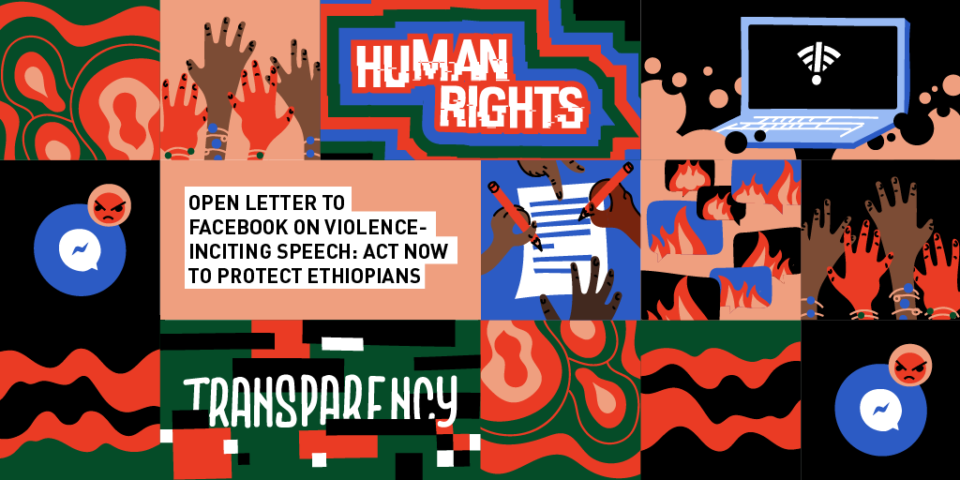Overseas, Social Media’s Disinformation Kills
Ozy Lesson: Investors Want ‘Safe’ Black Content
Kenya, Ecuador, Chile Leaders in ‘Pandora Papers’
A Haitian American Plea for Unity in Diaspora
N.Y. Times Museum Reflects the American Story
L.A. Times Digitizes Past, Looks to Future
Latinos Still Must Make Case for Ad Dollars
Text in N.Y. Times ‘Unequal Opportunity’ Exhibit
Friday Is Deadline to Nominate a J-Educator
Homepage photo: “Open letter to Facebook on violence-inciting speech: act now to protect Ethiopians,” July 27, 2020, by accessnow.org
Support Journal-ismsOverseas, Social Media’s Disinformation Kills
The world heard Facebook whisteblower Frances Haugen say last week that the social media giant is partially responsible for teenage girls considering suicide because of the body shame they felt after using Instagram.
Less attention was paid to the assertions that Facebook has blood on its hands because of the disinformation spread on its platform, particularly in the conflict areas of Myanmar and Ethiopia, where thousands have died.
“ ‘What we saw in Myanmar and are now seeing in Ethiopia are only the opening chapters of a story so terrifying, no one wants to read the end of it,’ Haugen said in her striking testimony,” Emmanuel Akinwotu wrote Thursday in the Guardian. “Haugen warned that Facebook was ‘literally fanning ethnic violence’ in places such as Ethiopia because it was not policing its service adequately outside the US.”
After winning the Nobel Peace Prize on Friday, Philippines journalist Maria Ressa reiterated that Facebook had become the world’s largest distributor of news, “yet it is biased against facts, it is biased against journalism … If you have no facts, you can’t have truths, you can’t have trust. If you don’t have any of these, you don’t have a democracy,” Michael Savage reported Saturday for The Guardian. Critics say Facebook’s algorithms favor postings that will generate emotion and clicks over facts, even if the postings amount to disinformation.
Vice.com reported last year on the killing of Ethiopian singer Hachalu Hundessa, whose “death at age 34 set off a wave of violence in the capital and his home region of Oromia. Hundreds of people were killed, with minorities like Christian Amharas, Christian Oromos, and Gurage people suffering the biggest losses.
“This bloodshed was supercharged by the almost-instant and widespread sharing of hate speech and incitement to violence on Facebook, which whipped up people’s anger. Mobs destroyed and burned property. They lynched, beheaded, and dismembered their victims. . . .”
Justin Scheck, Newley Purnell and Jeff Horwitz of The Wall Street Journal wrote of Ethiopia in September, a month before Haugen’s testimony. They said, “The company’s internal communications show it doesn’t have enough employees who speak some of the relevant languages to help monitor the situation (paywall). For some languages, Facebook also failed to build automated systems, called classifiers, that could weed out the worst abuses. Artificial-intelligence systems that form the backbone of Facebook’s enforcement don’t cover most of the languages used on the site.
“Facebook also doesn’t publish the ‘community standards’ it requires users to abide by in all of the languages it serves in Ethiopia, so some users may not know the rules they are supposed to follow.
“Facebook said this week the standards are available in some Ethiopian languages and that it has started translating them into others.
“In a December planning document, a Facebook team wrote that the risk of bad consequences in Ethiopia was dire, and that ‘most of our great integrity work over the last 2 years doesn’t work in much of the world.’ It said in some high-risk places like Ethiopia, ‘Our classifiers don’t work, and we’re largely blind to problems on our site.’
“Groups associated with the Ethiopian government and state media posted inciting comments on Facebook against the Tigrayan minority, calling them ‘hyenas’ and ‘a cancer.’ Posts accusing Tigrayans of crimes such as money laundering were going viral, and some people on the site said the Tigrayans should be wiped out. . . .”
Meanwhile, in a September report, “Fueling the Fire: How Social Media Intensifies U.S. Political Polarization — and What Can Be Done About It,” [PDF], New York University’s Paul M. Barrett, Justin Hendrix and J. Grant Sims included a section on Ressa’s home country:
“Perhaps nowhere has social media’s potential to divide people been more clearly demonstrated than in the Philippines. There, President Rodrigo Duterte has built a Facebook-powered propaganda machine that has intimidated critics and made a mockery of democratic aspirations. It started with Duterte’s successful 2016 presidential campaign, notable for his violent rhetoric on drug dealers.
“As his message spread on Facebook, Duterte’s popularity grew. Local ‘influencers’ hoping to capitalize on his new-found fame began distributing pro-Duterte propaganda to millions of Facebook followers. At one point in the campaign, nearly two-thirds of Facebook conversations in the Philippines were about him.
“After he assumed the presidency, Duterte’s massive online following morphed into an instrument of state power. Maria Ressa, founder of the Philippines’ largest online news site, Rappler, watched with increasing concern as Duterte’s government harnessed Facebook to silence critics and spread propaganda. In one particularly nasty episode, partisans of Duterte took down an opposition senator by spreading doctored pornographic images and lies about her personal finances.
“After publishing an article critical of the government’s online activities, Ressa herself became a target of Duterte’s trolls. Fake accounts inundated her with hate mail, sending as many as 90 messages an hour. In 2019, she was arrested and later convicted on trumped-up charges of ‘cyber-libel,’ which carries a prison sentence of up to six years.”
Meanwhile, the Guardian story addressed Myanmar.
“About half of Myanmar’s population of 53 million use Facebook, with many relying on the site as their primary source of news. In June this year, an investigation by the rights group Global Witness found that Facebook’s algorithm was promoting posts in breach of its own policies that incited violence against protesters marching against the coup launched by the military in February.”
John Allen reported Thursday for allAfrica.com, “Haugen told the Senate sub-committtee that 87 percent of ‘integrity funding’ – the money Facebook spends on combatting misinformation – is spent on content in English, despite only nine percent of Facebook users being English speakers. In Ethiopia, ‘integrity systems’ were used for only two of six languages used.
“Facebook founder, CEO and chairman, Mark Zuckerberg, hit back strongly at Haugen on his Facebook page. ‘We care deeply about issues like safety, well-being and mental health,’ he said. ‘It’s difficult to see coverage that misrepresents our work and our motives. At the most basic level, I think most of us just don’t recognize the false picture of the company that is being painted. ‘. . .”
- Asian American Journalists Association: AAJA Congratulates Member Maria Ressa, Nobel Peace Prize Recipient
- Gabriela Baron, Manila Bulletin: Media groups hail Maria Ressa’s Nobel win
- Karissa Bell, Yahoo: Researchers: Platforms like Facebook have played ‘major role’ in fueling polarization
- Nima Elbagir, Gianluca Mezzofiore, Katie Polglase, Barbara Arvanitidis and Mark Baron, CNN: Ethiopia used its flagship commercial airline to transport weapons during war in Tigray
- Robin Givhan, Washington Post: The whistleblower came to advocate for humans over algorithms
- Emil Guillermo, Asian American Legal Defense and Education Fund: Asian American Filipina Journalist Maria Ressa wins Nobel Peace Prize
Ozy Lesson: Investors Want ‘Safe’ Black Content
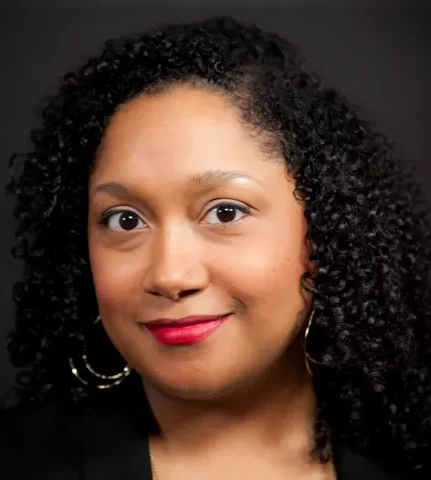 “Like many others in the media business, I couldn’t look away from the drama that unfolded last week around Carlos Watson (pictured, below) and his company Ozy Media,” Lauren Williams (pictured) wrote Tuesday for The New York Times. “Once a Black-run media darling among investors and advertisers, it’s now at least temporarily shuttered after a New York Times column exposed its inflated audience metrics, a fraud allegation and other concerning business practices.
“Like many others in the media business, I couldn’t look away from the drama that unfolded last week around Carlos Watson (pictured, below) and his company Ozy Media,” Lauren Williams (pictured) wrote Tuesday for The New York Times. “Once a Black-run media darling among investors and advertisers, it’s now at least temporarily shuttered after a New York Times column exposed its inflated audience metrics, a fraud allegation and other concerning business practices.
“For a lot of observers, the Ozy saga is just another too-wild-to-be-true scammer story that entertains and disgusts in equal measure. For me, a Black media entrepreneur, it’s a little more meaningful than that — a stark reminder of the type of company and content that attracts the big money and how few profitable paths exist for serious Black news.
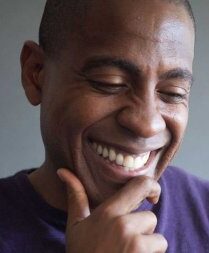 “When I left my position as the top editor at Vox to build Capital B, a nonprofit news organization for Black audiences, my co-founder, Akoto Ofori-Atta, and I were sure of two things.
“When I left my position as the top editor at Vox to build Capital B, a nonprofit news organization for Black audiences, my co-founder, Akoto Ofori-Atta, and I were sure of two things.
“The first is that we would be uncompromising in our mission to prioritize deep original reporting on the serious topics that affect Black lives across America — public health, education, politics, criminal justice, the environment and housing.
“The second was that there was absolutely no way we could do the first as a for-profit, Black-run media company.
“The work we plan to publish is important, and the audience we plan to serve deserves it. But outside of a subscription model, which few new players can pull off, the business imperatives often point in the opposite direction. Safe, innocuous content is what attracts advertisers, if not audience. . . .”
- Craig Newmark Graduate School of Journalism, City University of New York: Why Black Media Matters Now
- Sarah Ellison and Jeremy Barr, Washington Post: Ozy Media’s audience was mostly a mirage. Even in scandal, founder Carlos Watson is looking for opportunity.
- Angela Fu, Poynter Institute: Nonprofit outlets dedicated to covering local news and communities of color are on the rise, report finds
- Roland Martin, Facebook: #RMU to Ozy Media’s ad clients: Support Black Star Network. Real Numbers . . .
- Jessica Mathews, Fortune: How Ozy Media, a startup with $70 million in funding and a star-studded list of investors, collapsed in 6 days
- Kelly McBride, NPR: An NPR board member resigns
- Jemima McEvoy, Forbes: Ex-Ozy Media Employees Say Company Used Dubious Tactics To Build Newsletter Following, Raising Legal Questions
- Media Impact Funders: 2021 Annual Journalism Funders Gathering, Oct. 13-14 (virtual)
- Eugene S. Robinson, blog: OZY Rules: The House Negro Gets It in the End
- Eugene S. Robinson, New York Times: Let Me Tell You What It Was Like to Work at Ozy
- Antoinette Siu, The Wrap: Former Ozy Editor Suggests It Was Carlos Watson Who Impersonated Google Exec on Investment Call (video)
- Ben Smith and Katie Robertson, New York Times: Ozy Media is accused in a lawsuit of ‘fraudulent conduct.’

Kenya, Ecuador, Chile Leaders in ‘Pandora Papers’
Kenyan President Uhuru Kenyatta and his family are among the world leaders said to have hidden away billions of dollars in secret offshore accounts. So are Guillermo Lasso, a banker who was elected as Ecuador’s president in April, and Sebastián Piñera, an investor, businessman, and investor who is president of Chile.
As Ramishah Maruf of CNN reported Oct. 4, “The International Consortium of Investigative Journalists (ICIJ) on Sunday released the ‘Pandora Papers,’ an exposé of the financial secrets and offshore dealings of dozens of heads of state, public officials and politicians from 91 countries and territories.
“More than 600 journalists from 150 outlets spent two years investigating nearly 12 million confidential files — a bigger cache of documents than 2016’s Panama Papers.
“The Pandora Papers reveal how unusual offshore finances and secretive wealth have infiltrated global politics. Some of the people named in the papers are major political leaders in developing or impoverished countries, such as Jordan and Kenya. . . .”
The Voice of America reported Oct. 4 that records obtained by ICIJ “show the Kenyatta family has a half-billion-dollar fortune tied up in at least seven foundations and tax havens in various countries, including Panama and the British Virgin Islands.
“The family enlisted the services of one of the largest banks in Switzerland, Union Bancaire Privee, to register and establish a foundation in Panama to manage and shelter its wealth, which it began building under its patriarch, Jomo Kenyatta, who became Kenya’s first president in 1964 after it gained independence from Britain. . . .”

The ICIJ report named Lasso as “another wealthy Latin American who set up trusts in South Dakota. . . . Leaked records show that Lasso moved assets into two trusts in South Dakota in December 2017, three months after Ecuador’s parliament passed a law prohibiting public officials from holding assets in tax havens. The records show that Lasso moved two offshore companies to the South Dakota trusts from two secretive foundations in Panama. . . .
“Clearly the U.S. is a big, big loophole in the world,’ said Yehuda Shaffer, former head of the Israeli financial intelligence unit. ‘The U.S. is criticizing all the rest of the world, but in their own backyard, this is a very, very serious issue.’ “
 On Friday, Brenda Medina and Malia Politzer reported for ICIJ, “Chile’s national prosecutor’s office announced Friday that it would open a criminal investigation against President Sebastián Piñera (pictured) following revelations concerning his business affairs in the Pandora Papers.
On Friday, Brenda Medina and Malia Politzer reported for ICIJ, “Chile’s national prosecutor’s office announced Friday that it would open a criminal investigation against President Sebastián Piñera (pictured) following revelations concerning his business affairs in the Pandora Papers.
“Investigators said the probe would focus on the 2010 sale by the Piñera family of a stake in a Chilean mining project and, depending upon the findings, could lead to bribery and tax-related charges. . . .”
- Associated Press: A look at world leaders named in the Pandora Papers
- Capital News, Nairobi, Kenya: Uhuru On Pandora Papers: I’ll Respond Comprehensively
U.S. Border Patrol agents on horseback aggressively dispersing Haitian migrants on Sept. 21. “It is about time that we Haitians come to the realization that we are Black Americans, just with a different accent,” writes Garry Pierre-Pierre. (Credit: YouTube)
A Haitian American Plea for Unity in Diaspora
“Growing up in Elizabeth, NJ, I and the handful of Haitian kids who lived there would sometimes get into schoolyard spats with our African American classmates,” Garry Pierre-Pierre (pictured), founder and publisher of the Haitian Times in New York, wrote Oct. 1.
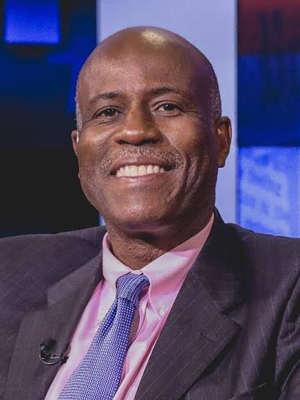
“In the heat of the moment, the African American kids would call us ‘Frenchy’ because of our surnames and accents. We would shoot back, ‘I’m not French, I’m Haitian.’
“It would go on like this for a while, with the typical harmless things kids do. Then, we came to realize that these taunts were out of envy and nothing more. ‘Say something in French,’ they would ask. We would say something banal, and we all would laugh.
“When I first saw African Americans, I actually thought they were Haitians. In my innocence, I thought every Black person was Haitian. I remember saying to my mom that I didn’t know there were so many ‘Haitians’ in New York. . . .”
He also wrote that it’s time for the current generation, which “has embraced their African American and Caribbean cousins, moored solidly in their ‘Haitianity,’ to coin a word, to rise. They, more than anybody, understand this moment. It is their moment to show the world where Black unity can take us.
“The time for petty division is over. Haitians, Black Americans, Caribbean Americans and now continental Africans must realize that they are not competitors. We are collaborators facing an ever-rising tide of white nationalism in the world bent on pushing us back and holding us down.
“If we can gain that unity, we can make the Black Indigenous People of Color (BIPOC) coalition into a broader movement for social change, along with like-minded whites who support our cause.”
- Roy S. Johnson, al.com: Haitian migrants yearn to breathe free, just like many of your ancestors (Sept. 25)
- Ruben Navarrette Jr., Washington Post Writers Group: Haitian refugees are testing Americans (Oct. 1)
- Garry Pierre-Pierre, Haitian Times: Let’s do without the self-cannibalism directed at Haitians doing their jobs
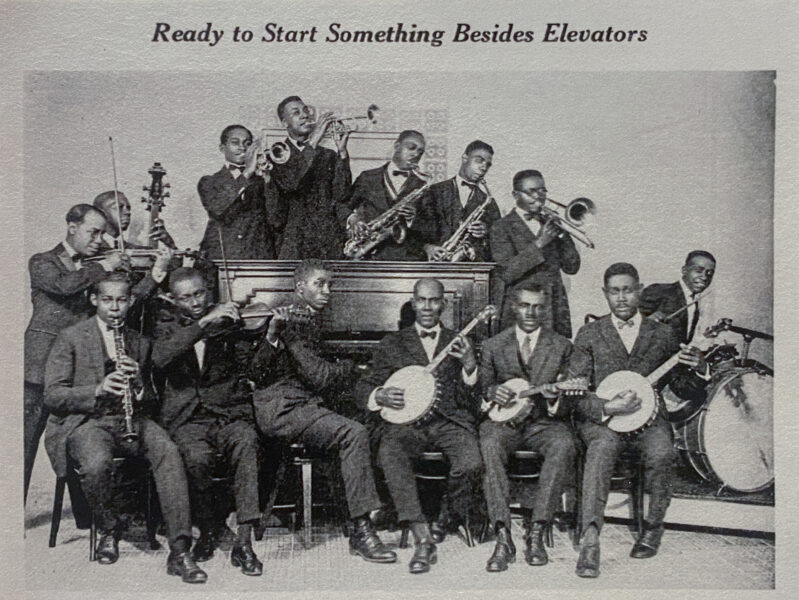
“Photograph in The Little Times, Aug. 1, 1924. With professional ranks closed to African-Americans, job opportunities were limited to elevator operators and building porters. This was one of few photographs of Black employees in the house organ,” the museum states.” (Photo credits: New York Times)
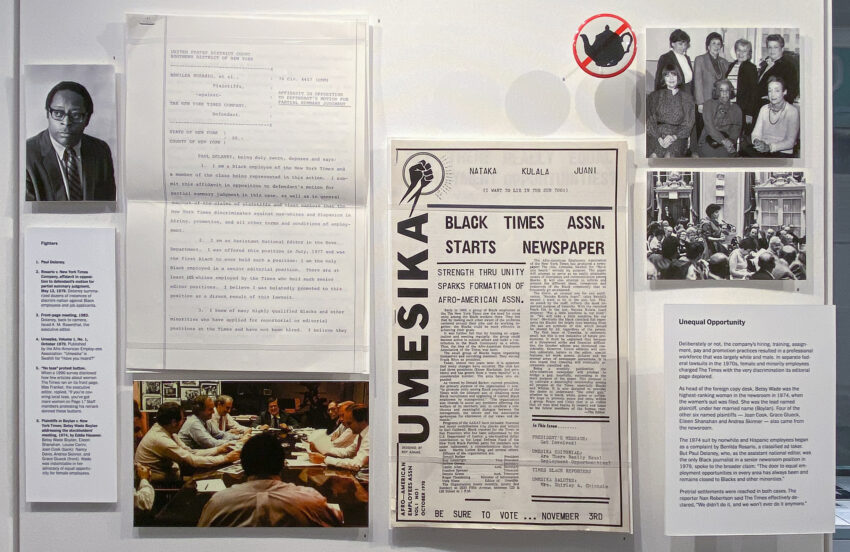
N.Y. Times Museum Reflects the American Story
The New York Times has opened its own in-house “Timeseum” — officially the Museum at The Times — in its Manhattan building, and its sweep of Times history reflects the American story as well.
Among the artifacts are the publisher’s guest book from 1962 to 1966. Martin Luther King Jr. signed it on Sept.10, 1965, when he and fellow civil rights figures Andrew J. Young, Bayard Rustin, Harry H. Wachtel and Bernard S. Lee were guests.
There is the full-page advertisement paid for by civil rights activists that prompted the Supreme Court case Times v. Sullivan. The decision established that newspapers could not successfully be sued for libel unless it could be proved that they acted with actual malice – “that is, with knowledge that it was false or with reckless disregard for the truth.”
Similarly, there are documents from the 1972 case in which the U.S. Court of Appeals found that requiring reporter Earl Caldwell to testify about the Black Panther Party, which he had been covering, would amount to censorship and violate the First Amendment protection of freedom of the press.
Also included are the 1930 editorial in which The Times bowed to an NAACP campaign and capitalized the word “Negro”; and documentation of the battles, legal and otherwise, by African Americans, women and LGBTQ people over hiring and coverage.
The artifacts are as current as the plastic handcuffs used to restrain reporter Nicholas Bogel-Burroughs, who was detained by the police in Brooklyn Center, Minn., on April 13 during protests over the killing of Daunte Wright.
The 15th-floor treasure is designed for employees and their families and is not open to the public.

L.A. Times Digitizes Past, Looks to Future
Underscoring Executive Editor Kevin Merida’s pledge to take the Los Angeles Times into new venues, the news organization announced this week that, “We will add 15 positions — nine to grow the core audience team and an additional six aimed at producing lively, original content that will pop on social platforms from Twitter to Instagram to TikTok and beyond.“
And in a nod to its past, “This week, the Los Angeles Times re-introduced readers to ‘Black L.A.: Looking at Diversity,’ a 22-story series that ran in the newspaper over a three-week span in 1982. Created by a team of Black reporters and editors, the series included stories of success, struggle, art, politics, family, culture, education, sports, media, policing, racism and history.”
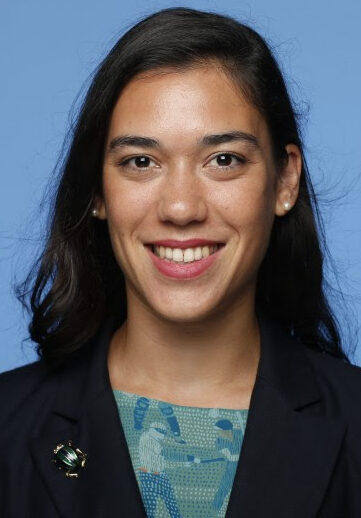 Accompanying the expansion of the social platform team, Samantha Melbourneweaver (pictured) was promoted to assistant managing editor for audience.
Accompanying the expansion of the social platform team, Samantha Melbourneweaver (pictured) was promoted to assistant managing editor for audience.
”In the three years since she started at The Times, Melbourneweaver has transformed a tiny team of a few key audience editors into a powerhouse group interwoven in every department and facet of our journalism.
“The promotion comes with a significant expansion of our audience team that will enhance The Times’ ability to reach new subscribers and extend our journalism’s impact. Elevating this audience-focused role is also a reflection of how important this work is for The Times.”
The “Black LA” stories “were digitally published in their original text on Oct. 4, along with an introductory essay by Columnist Sandy Banks, who was part of the reporting team 39 years ago. Banks’ column looks back at how the project came together and why the stories are still relevant today.
“She writes: ‘The year was 1982 and, like most of my Black newsroom colleagues, I was still wounded and fuming over an incendiary front-page series The Times had run the year before titled “Marauders from inner city prey on L.A.’s suburbs” depicting young Black men as ‘savage’ inner-city ‘marauders’ preying on the city’s wealthy white suburbs.’ ”
The Times also wrote, “Multiplatform Editor Christian Orozco said the idea to revive the series came last year, after the newsroom brought the 1983 Pulitzer Prize-winning series on Southern California’s Latino community into its digital archives. ‘In doing research, it was obvious that the ‘Black L.A.’ project had a huge influence on the series,’ Orozco said. ‘Frank Sotomayor and Louis Sahagún, who were part of the team, wrote about ‘Black L.A’ in their pieces about the Latino series. That’s what started the journey to this project.’ ”
Among the newly digitized pieces is, “The media’s treatment of Blacks: A story of distortion,” by Austin Scott,
and “Black reporter finds doors hard to open” by Lee Harris (paywall).
- S. Mitra Kalita, Time: A Woman of Color Cannot Save Your Workplace Culture (Sept. 28)
- Ben Morse, Current: New ‘NewsHour’ initiative deepens reporting on diverse communities (Oct. 1)
- Michael O’Connell, Better News: Tennessean engages Black audiences with new initiative
- Laura Hazard Owen, Nieman Lab: The LA Times’ Kevin Merida thinks Los Angeles is “the perfect place to redefine the modern newspaper” (Sept. 23)
- Laura Rodriguez Presa, Darcel Rockett and Erin Hooley, Chicago Tribune: We hear your disappointment about how Chicago’s communities of color are covered. We are journalists who want to do better. (Sept. 30) (paywall)
NBC prepared this preview of its Hispanic Heritage Month special, “American Voices: Latinos Inside the White House,” anchored by Alicia Menendez, which aired Sunday on MSNBC.
Latinos Still Must Make Case for Ad Dollars
“Hispanic Heritage Month seeks to put a spotlight on a large and growing segment of the U.S. population. But it also highlights the lack of year-round support Spanish-language publishers receive from advertisers,” Sara Guaglione reported Oct. 4 for Digiday.
“While progress is being made — especially given the focus on diversity and inclusion efforts in the past year and new census data showing the growth of the Hispanic population in the U.S. — both publishers and ad agencies are still having to make a case for the value of reaching this audience.
“Key details:
“Hispanic Heritage Month, which began on Sept. 15 and runs through Oct. 15, is a key time for increased ad revenue and for new advertisers to work with Spanish-language publishers.
“However, publishers and ad agencies both lament the slow progress of brands’ ad spend in this area and recognition of the importance and opportunity of reaching Hispanic people in the U.S. year-round.
“Spanish-language publishers that reach U.S. Hispanic audiences do not produce much special content around Hispanic Heritage Month because celebrating and recognizing the contributions from this community are what they do daily, they said. . . .”
- Paradise Afshar, Atlanta Journal-Constitution: Project shines light on Hispanic essential workers (Sept. 27)
- Stephen Battaglio, Los Angeles Times: NBC News anchor Tom Llamas taps into his roots for a new streaming newscast (Sept. 20) (paywall)
- Jeffrey Brown and Anne Azzi Davenport, “PBS NewsHour”: This author traveled across the country to ask: What does it mean to be Latino? (Aug. 13)
- Code Switch, NPR: Who You Calling ‘Hispanic’? (Sept. 22) (podcast)
- Silvia Foster-Frau and Rachel Hatzipanagos, Washington Post: Somos Latina: Latinos across the country are embracing their power in a shifting America (Oct. 1)
- Suzanne Gamboa, NBC: Latino members of Biden’s Cabinet defend policies on Covid, immigration
- Suzanne Gamboa and Nicole Acevedo, NBC News: The new Latino landscape: The swift growth of U.S. Latinos is reshaping big states and small towns. Meet the faces of a new era. (Sept. 15)
- Nick Gardner, Adweek Podcast: Celebrating Hispanic Heritage Month: A candid conversation on the role of identity in the Latinx Community
- Oriana Gonzalez, Axios: Prominent Latinos urge NYT to keep publishing Spanish opinion journalism
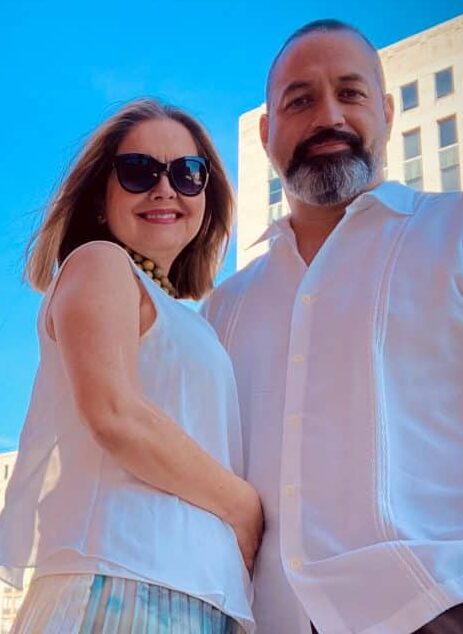 ILLatinoNews.com: Latino News Network Expands Local Coverage to Two New States (pictured: Anna and Hugo Balta)
ILLatinoNews.com: Latino News Network Expands Local Coverage to Two New States (pictured: Anna and Hugo Balta)
- Tom Llamas, “Today”: Tom Llamas on his parents’ escape from Cuba and growing up the son of refugees (Sept. 15)
- Mark Hugo Lopez, director of race and ethnicity research at Pew Research Center, shares key takeaways about the U.S. Latino population in the 2020 census. (NBCU Academy) (Sept. 21) (video)
- Natalie Morales, “Today”: How I respond to people who say I’m ‘not Latin enough’ (Sept. 15)
- Ralph Ortega, City and State: Editor’s Note: Why Hispanic Heritage Month matters
- Edward A. Rueda, NBCU Academy: Behind the Story: Putting faces on the “New Latino Landscape”
- Stephania Taladrid, New Yorker: The Exclusion of Latinos from American Media and History Books: Representative Joaquin Castro, releasing a report on Latino underrepresentation in Hollywood and the news industry, says, “Americans don’t know who Latinos are.” (Sept. 21)
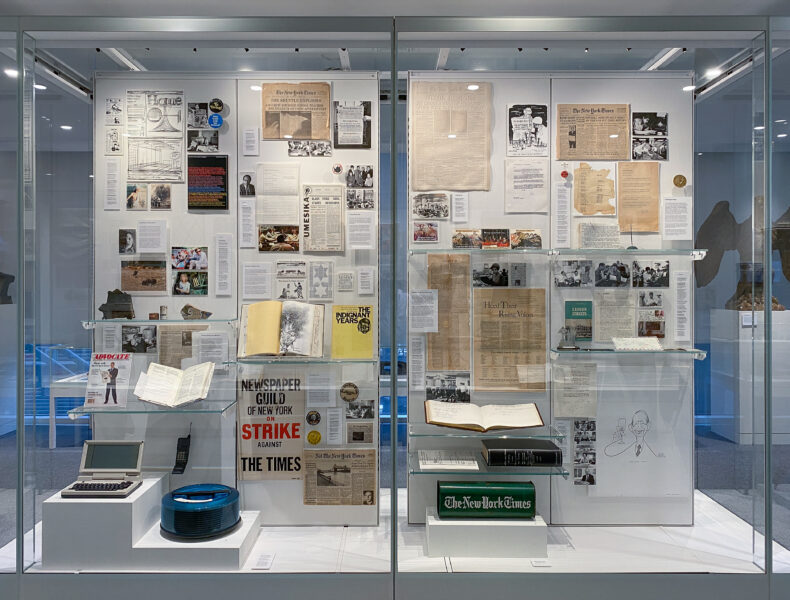
Text in N.Y. Times ‘Unequal Opportunity’ Exhibit
Text of the “Unequal Opportunity” portion of the Museum at The Times, referenced above:
Deliberately or not, the company’s hiring, training, assignment, pay and promotion practices resulted in a professional workforce that was largely white and male. In separate federal lawsuits in the 1970s, female and minority employees charged The Times with the very discrimination its editorial page deplored.
As head of the foreign copy desk, Betsy Wade was the highest-ranking woman in the newsroom in 1974, when the women’s suit was filed. She was the lead named plaintiff, under her married name (Boylan). Four of the other six named plaintiffs — Joan Cook, Grace Glueck, Eileen Shanahan and Andrea Skinner — also came from the newsroom.
The 1974 suit by nonwhite and Hispanic employees began as a complaint by Benilda Rosario, a classified ad taker. But Paul Delaney, who, as the assistant national editor, was the only Black journalist in a senior newsroom position in 1979, spoke to the broader claim: “The door to equal employment opportunities in every area has always been and remains closed to Blacks and other minorities.”
Pretrial settlements were reached in both cases. The reporter Nan Robertson said The Times effectively declared, “We didn’t do it, and we won’t ever do it anymore.”
- Paul Delaney.
- Rosario v. New York Times Company, affidavit in opposition to defendant’s motion for partial summary judgment, May 12, 1979. Delaney summarized dozens of instances of discrimination against Black employees and job applicants.
- Front-page meeting, 1983. Delaney, back to camera, faced A. M. Rosenthal, the executive editor.
- Umesika, Volume 1, No. 1, October 1970. Published by the Afro-American Employees Association. “Umesika” is Swahili for “Have you heard?”
- “No teas” protest button. When a 1990 survey disclosed how few articles about women The Times ran on its front page, Max Frankel, the executive editor, replied, “If you’re covering local teas, you’ve got more women on Page 1.” Staff members protesting his remark donned these buttons.
- Plaintiffs in Boylan v. New York Times; Betsy Wade Boylan addressing the stockholders’ meeting, 1974, by Eddie Hausner. Betsy Wade Boylan, Eileen Shanahan, Louise Carini, Joan Cook (back); Nancy Davis, Andrea Skinner, and Grace Glueck (front). Wade was indomitable in her advocacy of equal opportunity for female employees.
Turning a Deaf Ear and a Blind Eye
The word “gay” was finding its way into The Times in the 1960s. That halted in 1975, after the Travel section published a freewheeling and slightly racy account of a gay luxury cruise. The publisher, Arthur Ochs Sulzberger, and the managing editor, A. M. Rosenthal, were apoplectic.
“Gay” was then banned as a synonym for “homosexual.” Coverage of topics relevant to gay men and lesbians all but ceased. That included the growing AIDS epidemic (even though The Times had been one of the first news organizations to describe it, in 1981).
There was a marked improvement in coverage and in the treatment of L.G.B.T.Q. employees after Max Frankel succeeded Rosenthal as executive editor in 1986 and Arthur Ochs Sulzberger Jr. was appointed assistant publisher in 1987.
But the most dramatic milestone occurred on Dec. 21, 1990, when Jeffrey Schmalz, the deputy national editor, had a seizure in the newsroom. The seizure led to the discovery that he had AIDS and propelled him out of the closet. Schmalz became a national correspondent, covering AIDS and gay rights issues with blunt, fearless and startling insights, before he died, at 39, on Nov. 6, 1993.
1. The Advocate, Dec. 9, 1986. The Times was routinely — and harshly — criticized in the gay press.
2. Jeffrey Schmalz at his desk, 1992, by Annie Leibovitz.
3. Schmalz’s obituary, Nov. 7, 1993, by Richard J. Meislin.
4. “The New York Times Manual of Style and Usage,” 1976, by Lewis Jordan. The style book, which belonged to Thomas Feyer, when he was a copy editor on the foreign desk, is open to the page in which the use of “gay” is prohibited. Opposite is the superseding memo from Allan M. Siegal of June 15, 1987.
- Stephen Hiltner, New York Times: In the Heart of the Newsroom, a Nod to Journalists in Harm’s Way (March 21, 2017)
Friday Is Deadline to Nominate a J-Educator
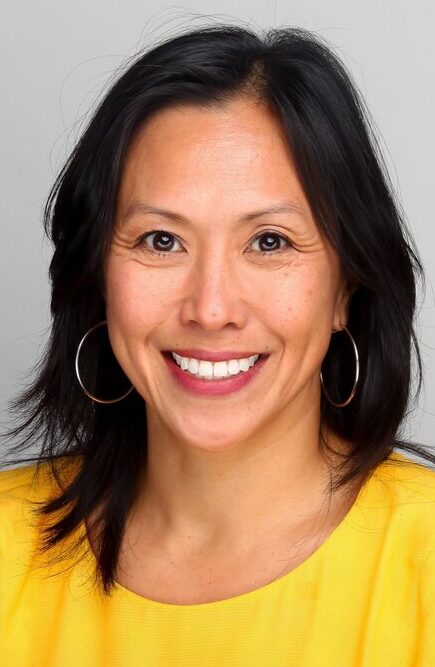
Mei-Ling Hopgood, 2020 recipient
Beginning in 1990, the Association of Opinion Journalists, now part of the News Leaders Association, annually granted a Barry Bingham Sr. Fellowship — actually an award — “in recognition of an educator’s outstanding efforts to encourage minority students in the field of journalism.”
Since 2000, the recipient has been awarded an honorarium of $1,000 to be used to “further work in progress or begin a new project.”
Past winners include James Hawkins, Florida A&M University (1990); Larry Kaggwa, Howard University (1992); Ben Holman, University of Maryland (1996); Linda Jones, Roosevelt University, Chicago (1998); Ramon Chavez, University of Colorado, Boulder (1999); Erna Smith, San Francisco State (2000); Joseph Selden, Penn State University (2001); Cheryl Smith, Paul Quinn College (2002); Rose Richard, Marquette University (2003).
Also, Leara D. Rhodes, University of Georgia (2004); Denny McAuliffe, University of Montana (2005); Pearl Stewart, Black College Wire (2006); Valerie White, Florida A&M University (2007); Phillip Dixon, Howard University (2008); Bruce DePyssler, North Carolina Central University (2009); Sree Sreenivasan, Columbia University (2010); Yvonne Latty, New York University (2011); Michelle Johnson, Boston University (2012); Vanessa Shelton, University of Iowa (2013); William Drummond, University of California at Berkeley (2014); Julian Rodriguez of the University of Texas at Arlington (2015) (video); David G. Armstrong, Georgia State University (2016) (video); Gerald Jordan, University of Arkansas (2017), Bill Celis, University of Southern California (2018); Laura Castañeda, University of Southern California (2019); and Mei-Ling Hopgood, Northwestern University (pictured) (2020).
Nominations may be emailed to Richard Prince, Opinion Journalism Committee, richardprince (at) hotmail.com. The deadline is Oct. 15. Please use that address only for NLA matters.
Support Journal-ismsTo subscribe at no cost, please send an email to journal-isms+subscribe@groups.io and say who you are.
Facebook users: “Like” “Richard Prince’s Journal-isms” on Facebook.
Follow Richard Prince on Twitter @princeeditor
Richard Prince’s Journal-isms originates from Washington. It began in print before most of us knew what the internet was, and it would like to be referred to as a “column.” Any views expressed in the column are those of the person or organization quoted and not those of any other entity. Send tips, comments and concerns to Richard Prince at journal-isms+owner@
View previous columns (after Feb. 13, 2016).
View previous columns (before Feb. 13, 2016)
- Diversity’s Greatest Hits, 2018 (Jan. 4, 2019)
- Book Notes: Is Taking a Knee Really All That? (Dec. 20, 2018)
- Book Notes: Challenging ’45’ and Proudly Telling the Story (Dec. 18, 2018)
- Book Notes: Get Down With the Legends! (Dec. 11, 2018)
- Journalist Richard Prince w/Joe Madison (Sirius XM, April 18, 2018) (podcast)
- Richard Prince (journalist) (Wikipedia entry)
- February 2018 Podcast: Richard “Dick” Prince on the need for newsroom diversity (Gabriel Greschler, Student Press Law Center, Feb. 26, 2018)
- Diversity’s Greatest Hits, 2017 — Where Will They Take Us in the Year Ahead?
- Book Notes: Best Sellers, Uncovered Treasures, Overlooked History (Dec. 19, 2017)
- An advocate for diversity in the media is still pressing for representation, (Courtland Milloy, Washington Post, Nov. 28, 2017)
- Morgan Global Journalism Review: Journal-isms Journeys On (Aug. 31, 2017)
- Diversity’s Greatest Hits, 2016
- Book Notes: 16 Writers Dish About ‘Chelle,’ the First Lady
- Book Notes: From Coretta to Barack, and in Search of the Godfather
- Journal-isms’ Richard Prince Wants Your Ideas (FishbowlDC, Feb. 26, 2016)
- “JOURNAL-ISMS” IS LATEST TO BEAR BRUNT OF INDUSTRY’S ECONOMIC WOES (Feb. 19, 2016)
- Richard Prince with Charlayne Hunter-Gault,“PBS NewsHour,” “What stagnant diversity means for America’s newsrooms” (Dec. 15, 2015)
- Book Notes: Journalists Follow Their Passions
- Book Notes: Journalists Who Rocked Their World
- Book Notes: Hands Up! Read This!
- Book Notes: New Cosby Bio Looks Like a Best-Seller
- Journo-diversity advocate turns attention to Ezra Klein project (Erik Wemple, Washington Post, March 5, 2014)
When you shop @AmazonSmile, Amazon will make a donation to Journal-Isms Inc. https://t.co/OFkE3Gu0eK
— Richard Prince (@princeeditor) March 16, 2018

